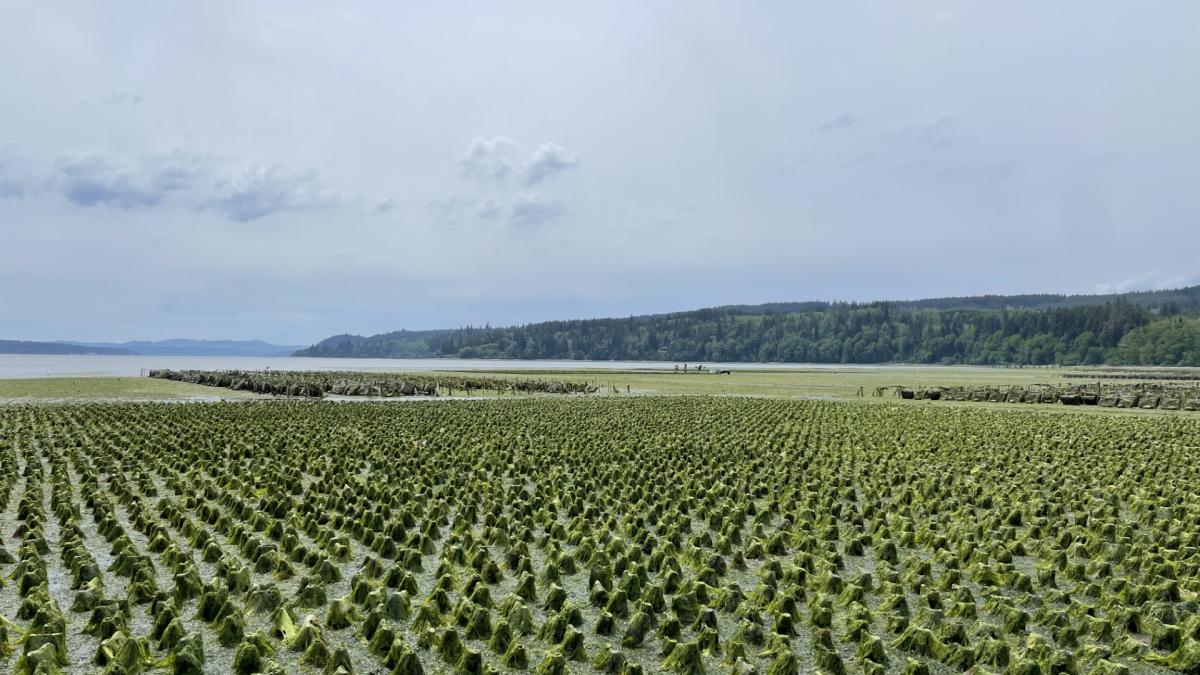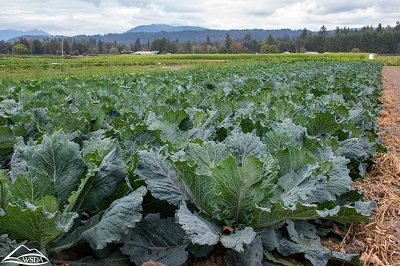
With funding from the USDA, UW researchers and partners will help farmers pilot an innovative new practice and build networks to enhance regional food system resilience
SEATTLE (March 20, 2024) — Washington’s farmers are on the front lines of climate change. Whether they are growing vegetables on farmland or raising shellfish on tidelands, farmers’ productivity and prosperity depends on a healthy environment. To help combat climate change while strengthening the regional food system, the University of Washington and partners are launching a new project to link up farms across the region, connecting sea to soil for climate resilience.

The project, titled Blue Carbon, Green Fields: Mobilizing Marine Algae to Benefit Sea and Soil in the Pacific Northwest, pilots an innovative approach to modernizing and scaling the age-old practice of using seaweed as a soil amendment, while providing growers of shellfish and specialty crops like vegetables with a new tool in their climate-smart agriculture toolboxes.
As seaweed and kelp grow in marine waters, they protect coastal ecosystems by limiting the harmful effects of ocean acidification, which makes it hard for shellfish to form their shells. The marine algae perform this service as they grow by absorbing excess carbon dioxide that contributes to ocean acidification, as well as sponging up nutrient pollution. However, the benefits are only temporary if seaweed and kelp are left to decompose in the marine environment.
Each year, shellfish farmers in Puget Sound remove nuisance seaweed, which thrives in nutrient-rich waters and fouls their beds and gear. The seaweed is typically left to decompose in the tidelands, returning its captured carbon and nutrients to nearshore waters.
“There is a better solution here that is not yet being realized,” noted Meg Chadsey of Washington Sea Grant, a partner in the new project.
As an alternative, harvesting seaweed from aquatic systems and applying it to agricultural soils is a strategy that could both lessen ocean acidification and improve soil quality on farms. Adding seaweed to farmland has the potential to replenish soil carbon, which is often depleted due to management practices such as tillage. Such a novel sea-to-soil channel for carbon sequestration could aid in mitigating climate change. The solution also carries the added benefit of improving overall soil quality, enhancing water and nutrient dynamics and building resilience to the impacts of climate change.

“This is really a win-win,” said Project Director Sarah Collier, assistant professor in the UW Department of Environmental & Occupational Health Sciences and the Food Systems, Nutrition, and Health program. “It creates a potential revenue stream out of what is currently a problem for shellfish growers, offers an exciting new natural soil amendment for specialty crop growers, and showcases a regional innovation that can help combat climate change.”
However, the knowledge base and community of practice to support this novel sea-to-soil solution does not yet exist. That’s why the Blue Carbon, Green Fields project is bringing together a team of interdisciplinary researchers and practitioners from around Puget Sound to tackle the challenges.
Researchers from the UW School of Public Health (Collier) and College of the Environment (Brittany Johnson, Sergey Rabotyagov and Eli Wheat), Washington Sea Grant (Chadsey) and the UW Bothell School of Interdisciplinary Arts and Sciences (Melanie Malone) are collaborating with Washington State University Extension, farm education and business incubator nonprofit Viva Farms, coastal restoration and conservation nonprofit Puget Sound Restoration Fund and local grower Baywater Shellfish.
Together, the team will provide shellfish and specialty crop growers with comprehensive technical assistance, perform rigorous environmental and economic analyses to capture the benefits of this practice, and establish a long-term framework to verify results.
Ultimately, the project aims to pave the way for future adoption of this practice across the Puget Sound region.
“What I especially like about this project is how it creates a regionally tailored pathway to building food system resilience,” said Michael Frazier, executive director of Viva Farms. “We are lucky to live in a place known for both specialty crops and shellfish, and yet there is potential to further the connection between land and sea growers who share values and a commitment to a healthy planet.”
The first order of business for the five-year project is to refine the logistics of seaweed harvest and application, and then to get a research network up and running. As the effort matures, the project team will be inviting both shellfish and specialty crop growers to join the network and pilot this new practice.
“This is welcome news for our region’s growers,” said Jodie Toft, deputy director of Puget Sound Restoration Fund. “With the diverse communities and types of expertise we are bringing together, we have an opportunity to create a scalable model of collective stewardship that will see benefits well beyond the scope of the project itself.”
This project is funded by the US Department of Agriculture’s Partnerships for Climate-Smart Commodities grant program.
To contact the study team, email bcgf@uw.edu.